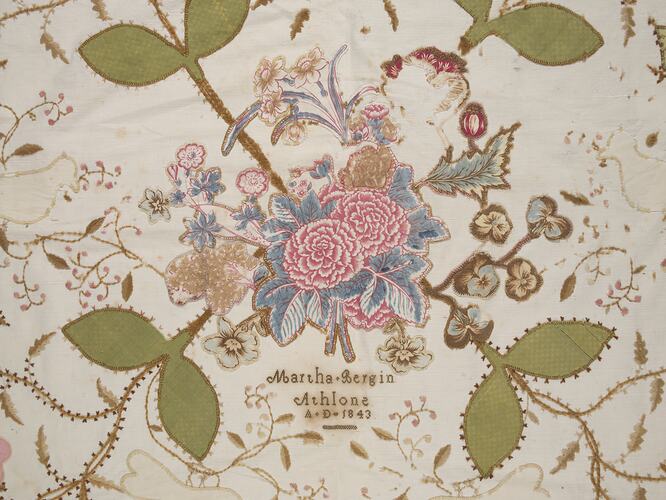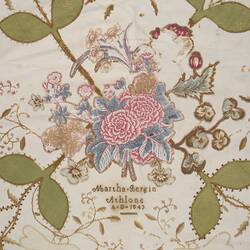Museums Victoria holds a rare example of textile-based material culture from the goldfields period of Victoria's history. It was made by Martha Bergin, born in 1822 at Rathdowney, Queens County (now County Laois), Ireland. Her father was a draper, which may explain the rich range of textiles which have been incorporated in the quilt and its strong base fabric. (The family drapery business continued for about 100 years after Martha's birth.) Martha appears to have been well-educated, since she wrote letters to her son each week later in life. About the age of 21, in 1843, she made the quilt, possibly for her dowry. Three years later, in May 1846, she married Andrew Tipping. Andrew had been born in 1824 in Castletown, County Westmeath. He was probably involved in land management and farming. Martha and Andrew had a son, after which Martha, her son and her sister travelled to New York in 1848, at the height of the Irish famine. She may have been visiting American relatives. There is no record to suggest that Andrew accompanied her. The immigration records describe Martha as a labourer.
Martha returned to Ireland shortly thereafter, and at some stage had another son. Both sons had died by 1851, when she and Andrew set out from Plymouth, England on the Beulah, bound for Australia. The quilt was amongst the objects they took with them; other linen, a family bible and the lace cap Martha wore when she married have also survived and remain with the family.
Martha and Andrew were assisted migrants, supported by the Colonial Land and Emigration Commission. Most other passengers on the Beulah were young women (170), with just 12 couples including Martha and Andrew as chaperones. Andrew was paid £2 as a constable during the voyage.
On their arrival in Hobart in September 1851, Martha and Andrew were found employment with a Mr Murray, but left Hobart after a short stay and moved to Melbourne. Their third son was baptised in Melbourne in July 1852, and lived to adulthood. By 1855 their fourth son had died in East Melbourne, and the following year they had another son, the first of their children born on the goldfields, at Fiery Creek. He lived for seven years. Two more daughters were born and died on the goldfields. Two of their children died of meningitis or encephalitis, and possibly one or two others may have died of diphtheria.
The family moved around the goldfields: Fiery Creek in 1856, Back Creek in 1859, Landsborough in 1862, Dunolly in 1863 and Bealiba in the 1870s. In 1872 Andrew took a freehold crown grant of 19 acres outside Bealiba and for the rest of his life worked the property with his surviving son, James. They worked as local contractors to support the family, including building roads and bridges for the local council. James left home in 1878, at the age of 26, but continued to send money to his parents. Andrew died of liver failure at the age of 58.
Martha was a determined woman who, and at the considerable age of 59, travelled for two weeks to assist her daughter-in-law during a family illness. She out lived Andrew by a year, dying at 61 from broncho-pneumonia.
References:
Tipping, J. (1991). Bush Teachers of Victoria: the story of the Tipping Family.
More Information
-
Keywords
-
Localities
Melbourne, Victoria, Australia, Hobart, Tasmania, Australia, Dunolly, Victoria, Australia, Bealiba, Victoria, Australia
-
Authors
-
Article types

